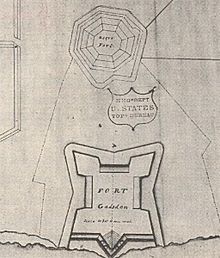British Fort | |
 | |
| Location | Franklin County, Florida |
|---|---|
| Nearest city | Sumatra |
| Coordinates | 29°56′N 85°1′W / 29.933°N 85.017°W |
| Area | 7 acres (2.8 ha) |
| Built | 1814 |
| NRHP reference No. | 72000318[1] |
| Significant dates | |
| Added to NRHP | February 23, 1972 |
| Designated NHL | February 23, 1972[2] |



Prospect Bluff Historic Sites (until 2016 known as Fort Gadsden Historic Site, and sometimes written as Fort Gadsden Historic Memorial)[4] is located in Franklin County, Florida, on the Apalachicola River, 6 miles (9.7 km) SW of Sumatra, Florida. The site contains the ruins of two forts.
The earlier and larger one was built by the British in 1814, during the War of 1812. They allowed the members of the disbanded Corps of Colonial Marines, made up largely of fugitive slaves, and Creek tribesmen to occupy it after the British evacuated Florida in 1815, deliberately leaving their munitions behind. At that point, since the British had not named it, Americans started referring to it as Negro Fort. It was destroyed in a river attack from U.S. forces in 1816.
Fort Gadsden was built in 1818 within the former walls of the former Negro Fort.
The site has been known by several other names at various times, including Prospect Bluff,[5]: 48 British post,[5]: 48 [6] Nicholls' Fort, Blount's Fort,[7][8] Fort Blount,[9] African Fort, and Fort Apalachicola.[10]: 60 The local natives called the land Achackwheithle.[11]
Listed in the National Register of Historic Places and named a National Historic Landmark in 1972, the Prospect Bluff Historic Sites was acquired by the Apalachicola National Forest in 1940 and is managed by the U.S. Forest Service.[2] The process of memorializing the site began in 1961, when the Apalachicola National Forest issued the State of Florida a term special use permit for an area of approximately 78 acres (32 ha) including the site to be run as a state park. Administration of the site reverted to the federal government[4] in the 1990s. The site contains interpretive signage, picnic area with pavilion, and rest rooms.[4]
- ^ "National Register of Historical Places - Florida (FL), Franklin County". National Register of Historic Places. National Park Service. September 22, 2007. Archived from the original on October 4, 2007. Retrieved September 23, 2007.
- ^ a b British Fort Archived May 2, 2009, at the Wayback Machine at National Historic Landmarks Program Archived September 27, 2007, at the Wayback Machine
- ^ Cox, Dale (2016). "The Defenses of Prospect Bluff (July 14, 1816)". exploresouthernmedia.com.
{{cite web}}: Missing or empty|url=(help) - ^ a b c Cite error: The named reference
npswas invoked but never defined (see the help page). - ^ a b Cite error: The named reference
Carlislewas invoked but never defined (see the help page). - ^ Life of Andrew Jackson. James Parton, Houghton, Mifflin and Company, 1880. p. 393. [1] Archived June 17, 2016, at the Wayback Machine
- ^ Giddings, Joshua Reed (1964). The exiles of Florida, or, The crimes committed by our government against the maroons, who fled from South Carolina, and other slave states, seeking protection under Spanish laws (1858). University of Florida Press. p. 46.
- ^ Nell, William C. (1855). The Colored Patriots of the American Revolution. Boston: Robert F. Wallcut. pp. 256–263.
- ^ Federal Writers' Project (1939), Florida. A Guide to the Southernmost State, New York: Oxford University Press, p. 489
- ^ Heidler, David S.; Heidler, Jeanne T. (2003). Old Hickory's War. Andrew Jackson and the Quest for Empire. Louisiana State University Press. ISBN 0807128678.
- ^ Clavin, Matthew J. (2019). The Battle of Negro Fort : the rise and fall of a fugitive slave community. New York. p. 22. ISBN 9781479837335.
{{cite book}}: CS1 maint: location missing publisher (link)

